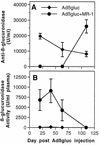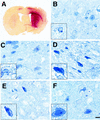Systemic and central nervous system correction of lysosomal storage in mucopolysaccharidosis type VII mice
- PMID: 10074197
- PMCID: PMC104107
- DOI: 10.1128/JVI.73.4.3424-3429.1999
Systemic and central nervous system correction of lysosomal storage in mucopolysaccharidosis type VII mice
Abstract
Mucopolysaccharidosis (MPS) type VII patients lack functional beta-glucuronidase, leading to systemic and central nervous system dysfunction. In this study we tested whether recombinant adenovirus that encodes beta-glucuronidase (Adbetagluc), delivered intravenously and into the brain parenchyma of MPS type VII mice, could provide long-term transgene expression and correction of lysosomal distension. We also tested whether systemic treatment with the immunosuppressive anti-CD40 ligand antibody, MR-1, affected transgene expression. We found substantial plasma beta-glucuronidase activity for over 9 weeks after gene transfer in the MR-1- treated group, with subsequent decline in activity corresponding to a delayed anti-beta-glucuronidase antibody response. At 16 weeks, near wild-type amounts of beta-glucuronidase activity and striking reduction of lysosomal pathology were detected in livers from mice that had received either MR-1 cotreatment or control antibody. In the lung and kidney, beta-glucuronidase activity was markedly higher for the MR-1-treated group. beta-Glucuronidase activity in the brain persisted independently of MR-1 treatment. Activity was intense in the injected hemisphere and was also evident in the noninjected cortex and striatum, with dramatic improvements in storage deposits in areas of both hemispheres. These results indicate that prolonged enzyme expression from transgenes delivered to deficient liver and brain can mediate pervasive correction and illustrate the potential for gene therapy of MPS and other lysosomal storage diseases.
Figures




References
-
- Bancroft J D. Enzyme histochemistry. In: Bancroft J D, Stevens A, editors. Theory and practice of histological techniques. New York, N.Y: Churchill Livingstone; 1982. pp. 387–388.
-
- Barr D, Tubb J, Ferguson D, Scaria A, Lieber A, Wilson C, Perkins J, Kay M A. Strain related variations in adenovirally mediated transgene expression from mouse hepatocytes in vivo: comparisons between immunocompetent and immunodeficient inbred strains. Gene Ther. 1995;2:151–155. - PubMed
-
- Birkenmeier E H, Barker J E, Vogler C A, Kyle J W, Sly W S, Gwynn B, Levy B, Pegors C. Increased life span and correction of metabolic defects in murine mucopolysaccharidosis type VII after syngeneic bone marrow transplantation. Blood. 1991;78:3081–3092. - PubMed
Publication types
MeSH terms
Substances
Grants and funding
LinkOut - more resources
Full Text Sources
Other Literature Sources
Medical
Molecular Biology Databases
Research Materials

